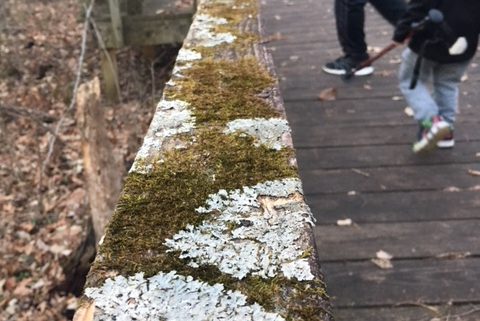Beaverdam Swamp at Wheeler NWR — Nature versus Boardwalk
I wrote recently that Judy and I took grandsons Jack and Sam to the nearby Beaverdam Swamp trail at Joe Wheeler National Wildlife Refuge January 31. See my Dormant Season Beauty blog post. We four enjoyed ourselves walking, talking, and observing.
Beyond what I previously reported, we all found fascination in the battle underway between the wooden boardwalk and the forces of Nature. We appreciated Nature’s artwork on a section of handrail:
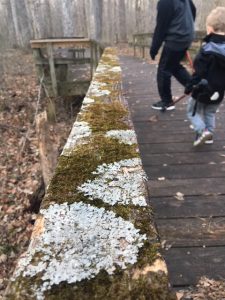
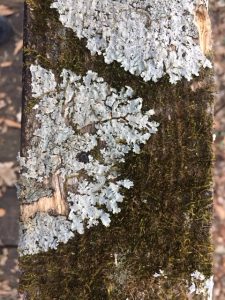
Lichens and mosses have colonized the wood rails, ensuring that moisture holds steady and decay progresses, and even accelerates. These lovely organisms are feasting — ashes to ashes, dust to dust. The cycles of life and death are ongoing. The decking likewise feels the ravage of a suite of demanding primary and secondary feeders. The action means little to the wood. It has already served its biological life functions… supporting its tree of origin and when still cambial, translocating vital water and dissolved nutrients and sugars vertically to and from the roots and leaves. Wood, and perhaps all living organisms, live and die, cycling and recycling the stuff of living from one life form to another. We pass judgement on the agents of decay only when we are asked to maintain the boardwalk:
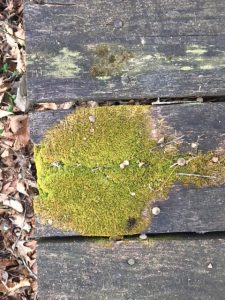
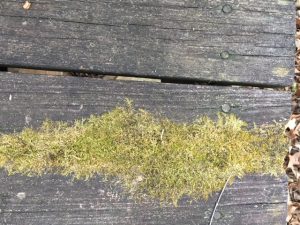
We visited the trail last winter, when we were forced to climb around and through a tree that had splintered a ten-foot segment of boardwalk. Small wonder — the boardwalk winds through an old growth forest that is, like most living communities, a dynamic ecosystem. Here’s a 30-inch diameter denizen that will eventually yield to gravity, taking yet another boardwalk segment with it:
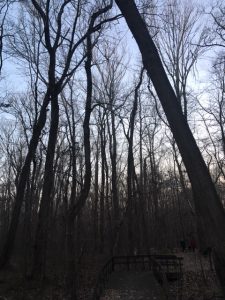
Decay weakens wood even without the force of a falling giant. Slipping past strength thresholds results in an accidentally well-placed pedestrian footfall snapping a board:
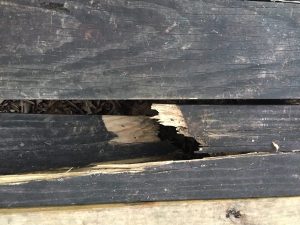
Note the recently replaced board adjacent to the broken member. The battle continues. Given time and deferred maintenance, Nature will prevail… always! Inexorably, the forces of time and decomposers will reduce all organisms to their simplest components — the cycle is complete, honed by 3.5 billion years of life on the mote-of-dust-Eden we call Earth. The community of organisms in a single board enriches a small corner of the world in ways that we humans can only aspire to match:
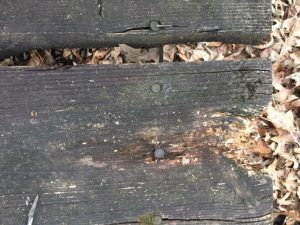
We see only a board decaying, bit by bit, cell by cell, the debris falling to the leaf-littered forest floor. Yet countless organisms are performing their designed life-functions as part of Nature’s grand scheme. Leonardo da Vinci observed 500 years ago, “There is no result in nature without a cause.”
I suggest that we humans should ask ourselves, “What is our cause?” Individually and societally. Explore the question deeply when you next find a contemplative moment in Nature. Do you have a cause more noble than recycling the stuff of life? What have you done recently to change some small corner of the Earth for the better?
I ask myself the same questions often. I hope to help others seek the answers via my writing, speaking, and counseling. Unless we individually, and in aggregate, seek and find the answers, we risk our species’ place in Earth’s future, relegating us perhaps to rare occurrences in Earth’s fossil record eons hence. And, that would indeed be sad and tragic:
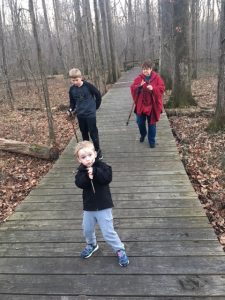
Never forget Nature’s Wisdom and Power and her lessons for living, learning, serving, and leading. And always remember that this Earth is a gift for which we share an obligation to appreciate and steward. Don’t let your grand-kids down… or theirs.

